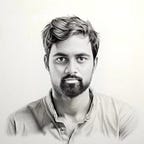Model That Will Recognize Characters on Number Plate
By- Sandeep Kumar Patel
Steps involved in License Plate Recognition
1. License Plate Detection: The first step is to detect the License plate from the car. We will use the contour option in OpenCV to detect for rectangular objects to find the number plate. The accuracy can be improved if we know the exact size, color and approximate location of the number plate. Normally the detection algorithm is trained based on the position of camera and type of number plate used in that particular country. This gets trickier if the image does not even have a car, in this case we will an additional step to detect the car and then the license plate.
2. Character Segmentation: Once we have detected the License Plate we have to crop it out and save it as a new image. Again this can be done easily using OpenCV.
3. Character Recognition: Now, the new image that we obtained in the previous step is sure to have some characters (Numbers/Alphabets) written on it. So, we can perform OCR (Optical Character Recognition) on it to detect the number
1. License Plate Detection
Let’s take a sample image of a car and start with detecting the License Plate on that car. We will then use the same image for Character Segmentation and Character Recognition as well. If you want to jump straight into the code without explanation then you can scroll down to the bottom of this page
OpenCV: Automatic License/Number Plate Recognition (ANPR) with Python
My first run-in with ANPR was about six years ago.
After a grueling three-day marathon consulting project in Maryland, where it did nothing but rain the entire time, I hopped on I-95 to drive back to Connecticut to visit friends for the weekend.
Python Code Sandeep.py-
img = cv2.imread(“testData/sample15.jpg”)
print(“Number input image…”,)
cv2.imshow(“input”,img)
if cv2.waitKey(0) & 0xff == ord(‘q’):
pass
img2 = cv2.GaussianBlur(img, (3,3), 0)
img2 = cv2.cvtColor(img2, cv2.COLOR_BGR2GRAY)
img2 = cv2.Sobel(img2,cv2.CV_8U,1,0,ksize=3)
_,img2 = cv2.threshold(img2,0,255,cv2.THRESH_BINARY+cv2.THRESH_OTSU)
element = cv2.getStructuringElement(shape=cv2.MORPH_RECT, ksize=(17, 3))
morph_img_threshold = img2.copy()
cv2.morphologyEx(src=img2, op=cv2.MORPH_CLOSE, kernel=element, dst=morph_img_threshold)
num_contours, hierarchy= cv2.findContours(morph_img_threshold,mode=cv2.RETR_EXTERNAL,method=cv2.CHAIN_APPROX_NONE)
cv2.drawContours(img2, num_contours, -1, (0,255,0), 1)
for i,cnt in enumerate(num_contours):
min_rect = cv2.minAreaRect(cnt)
if ratio_and_rotation(min_rect):
x,y,w,h = cv2.boundingRect(cnt)
plate_img = img[y:y+h,x:x+w]
print(“Number identified number plate…”)
cv2.imshow(“num plate image”,plate_img)
if cv2.waitKey(0) & 0xff == ord(‘q’):
pass
if(isMaxWhite(plate_img)):
clean_plate, rect = clean2_plate(plate_img)
if rect:
fg=0
x1,y1,w1,h1 = rect
x,y,w,h = x+x1,y+y1,w1,h1
# cv2.imwrite(“clena.png”,clean_plate)
plate_im = Image.fromarray(clean_plate)
text = tess.image_to_string(plate_im, lang=’eng’)
print(“Number Detected Plate Text : “,text)
import tkinter as tk
from tkinter import filedialog
from tkinter import *
from PIL import ImageTk, Image
from tkinter import PhotoImage
import numpy as np
import cv2
import pytesseract as tess
def clean2_plate(plate):
gray_img = cv2.cvtColor(plate, cv2.COLOR_BGR2GRAY)
_, thresh = cv2.threshold(gray_img, 110, 255, cv2.THRESH_BINARY)
num_contours,hierarchy = cv2.findContours(thresh.copy(),cv2.RETR_EXTERNAL, cv2.CHAIN_APPROX_NONE)
if num_contours:
contour_area = [cv2.contourArea(c) for c in num_contours]
max_cntr_index = np.argmax(contour_area)
max_cnt = num_contours[max_cntr_index]
max_cntArea = contour_area[max_cntr_index]
x,y,w,h = cv2.boundingRect(max_cnt)
if not ratioCheck(max_cntArea,w,h):
return plate,None
final_img = thresh[y:y+h, x:x+w]
return final_img,[x,y,w,h]
else:
return plate,None
def ratioCheck(area, width, height):
ratio = float(width) / float(height)
if ratio < 1:
ratio = 1 / ratio
if (area < 1063.62 or area > 73862.5) or (ratio < 3 or ratio > 6):
return False
return True
def isMaxWhite(plate):
avg = np.mean(plate)
if(avg>=115):
return True
else:
return False
def ratio_and_rotation(rect):
(x, y), (width, height), rect_angle = rect
if(width>height):
angle = -rect_angle
else:
angle = 90 + rect_angle
if angle>15:
return False
if height == 0 or width == 0:
return False
area = height*width
if not ratioCheck(area,width,height):
return False
else:
return True
top=tk.Tk()
top.geometry(‘900x700’)
top.title(‘Number Plate Recognition’)
top.iconphoto(True, PhotoImage(file=”/home/shivam/Dataflair/Keras Projects_CIFAR/GUI/logo.png”))
img = ImageTk.PhotoImage(Image.open(“logo.png”))
top.configure(background=’#CDCDCD’)
label=Label(top,background=’#CDCDCD’, font=(‘arial’,35,’bold’))
# label.grid(row=0,column=1)
sign_image = Label(top,bd=10)
plate_image=Label(top,bd=10)
def classify(file_path):
res_text=[0]
res_img=[0]
img = cv2.imread(file_path)
img2 = cv2.GaussianBlur(img, (3,3), 0)
img2 = cv2.cvtColor(img2, cv2.COLOR_BGR2GRAY)
img2 = cv2.Sobel(img2,cv2.CV_8U,1,0,ksize=3)
_,img2 = cv2.threshold(img2,0,255,cv2.THRESH_BINARY+cv2.THRESH_OTSU)
element = cv2.getStructuringElement(shape=cv2.MORPH_RECT, ksize=(17, 3))
morph_img_threshold = img2.copy()
cv2.morphologyEx(src=img2, op=cv2.MORPH_CLOSE, kernel=element, dst=morph_img_threshold)
num_contours, hierarchy= cv2.findContours(morph_img_threshold,mode=cv2.RETR_EXTERNAL,method=cv2.CHAIN_APPROX_NONE)
cv2.drawContours(img2, num_contours, -1, (0,255,0), 1)
for i,cnt in enumerate(num_contours):
min_rect = cv2.minAreaRect(cnt)
if ratio_and_rotation(min_rect):
x,y,w,h = cv2.boundingRect(cnt)
plate_img = img[y:y+h,x:x+w]
print(“Number identified number plate…”)
res_img[0]=plate_img
cv2.imwrite(“result.png”,plate_img)
if(isMaxWhite(plate_img)):
clean_plate, rect = clean2_plate(plate_img)
if rect:
fg=0
x1,y1,w1,h1 = rect
x,y,w,h = x+x1,y+y1,w1,h1
plate_im = Image.fromarray(clean_plate)
text = tess.image_to_string(plate_im, lang=’eng’)
res_text[0]=text
if text:
break
label.configure(foreground=’#011638', text=res_text[0])
uploaded=Image.open(“result.png”)
im=ImageTk.PhotoImage(uploaded)
plate_image.configure(image=im)
plate_image.image=im
plate_image.pack()
plate_image.place(x=560,y=320)
def show_classify_button(file_path):
classify_b=Button(top,text=”Classify Image”,command=lambda: classify(file_path),padx=10,pady=5)
classify_b.configure(background=’#364156', foreground=’white’,font=(‘arial’,15,’bold’))
classify_b.place(x=490,y=550)
def upload_image():
try:
file_path=filedialog.askopenfilename()
uploaded=Image.open(file_path)
uploaded.thumbnail(((top.winfo_width()/2.25),(top.winfo_height()/2.25)))
im=ImageTk.PhotoImage(uploaded)
sign_image.configure(image=im)
sign_image.image=im
label.configure(text=’’)
show_classify_button(file_path)
except:
pass
upload=Button(top,text=”Upload an image”,command=upload_image,padx=10,pady=5)
upload.configure(background=’#364156', foreground=’white’,font=(‘arial’,15,’bold’))
upload.pack()
upload.place(x=210,y=550)
sign_image.pack()
sign_image.place(x=70,y=200)
label.pack()
label.place(x=500,y=220)
heading = Label(top,image=img)
heading.configure(background=’#CDCDCD’,foreground=’#364156')
heading.pack()
top.mainloop()
Thank For Your Time….!!!!
